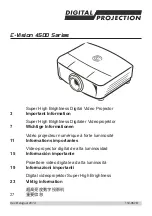
7
3 Service Navigation
3.1.
Introduction
This service manual contains technical information, which allow service personnel’s to understand and service this model.
Please place orders using the parts list and not the drawing reference numbers.
If the circuit is changed or modified, the information will be followed by service manual to be controlled with original service manual.
3.2.
General Description About Lead Free Solder (PbF)
The lead free solder has been used in the mounting process of all electrical components on the printed circuit boards used for this
equipment in considering the globally environmental conservation.
The normal solder is the alloy of tin (Sn) and lead (Pb). On the other hand, the lead free solder is the alloy mainly consists of tin
(Sn), silver (Ag) and Copper (Cu), and the melting point of the lead free solder is higher approx.30
°
C (86
°
F) more than that of the
normal solder.
Distinction of PCB Lead Free Solder being used
Service caution for repair work using Lead Free Solder (PbF)
• The lead free solder has to be used when repairing the equipment for which the lead free solder is used.
(Definition: The letter of “PbF” is printed on the PCB using the lead free solder.)
• To put lead free solder, it should be well molten and mixed with the original lead free solder.
• Remove the remaining lead free solder on the PCB cleanly for soldering of the new IC.
• Since the melting point of the lead free solder is higher than that of the normal lead solder, it takes the longer time to melt the
lead free solder.
• Use the soldering iron (more than 70W) equipped with the temperature control after setting the temperature at 350±30
°
C
(662±86
°
F).
Recommended Lead Free Solder (Service Parts Route.)
• The following 3 types of lead free solder are available through the service parts route.
RFKZ03D01K-----------(0.3mm 100g Reel)
RFKZ06D01K-----------(0.6mm 100g Reel)
RFKZ10D01K-----------(1.0mm 100g Reel)
Note
* Ingredient: tin (Sn) 96.5%, silver (Ag) 3.0%, Copper (Cu) 0.5%, Cobalt (Co) / Germanium (Ge) 0.1 to 0.3%
3.3.
Important Notice 1:(Other than U.S.A. and Canadian Market)
1. The service manual does not contain the following information, because of the impossibility of servicing at component level
without concerned equipment/facilites.
a. Schematic diagram, Block Diagram and PCB layout of MAIN PCB.
b. Parts list for invidual parts for MAIN PCB.
When a part replacement is required for repairing MAIN PCB, replace as an assembled parts. (Main PCB)
2. The following category is /are recycle module part. Please send it/them to Central Repair Center.
• MAIN PCB (VEP03H63A : SDR-S15P/PC)
• MAIN PCB (VEP03H63B : SDR-S15EC/EF/EG)
• MAIN PCB (VEP03H63C : SDR-S15GC)
• MAIN PCB (VEP03H63D : SDR-S15EE)
• MAIN PCB (VEP03H63E : SDR-S15GK)
• MAIN PCB (VEP03H63F : SDR-S15EP)
• MAIN PCB (VEP03H63G : SDR-S15PU)
• MAIN PCB (VEP03H63H : SDR-S15EB)
• MAIN PCB (VEP03H63J : SDR-S15GN)
• MAIN PCB (VEP03H63K : SDR-S15GJ)
• MAIN PCB (VEP03H63L : SDR-S15PR)
• MAIN PCB (VEP03H63M : SDR-S15GT)
• MAIN PCB (VEP03H63N : SDR-S15GD)
Summary of Contents for SDR-S15P
Page 9: ...9 4 Specifications For NTSC areas For PAL areas...
Page 10: ...10...
Page 15: ...15 8 Disassembly and Assembly Instructions 8 1 Disassembly Flow Chart 8 2 PCB Location...
Page 17: ...17 8 3 1 Removal of the Side case L unit Fig D1 Fig D2...
Page 22: ...22 8 3 13 Removal of the LCD unit Fig D16 8 3 14 Removal of the Monitor P C B Fig D17...
Page 23: ...23 8 3 15 Removal of the LCD panel Fig D18 8 3 16 Removal of the Side R P C B Fig D19...
Page 54: ...S7 2 LCD Section S 25 38 39 40 41 42 B29 B30 47 46 45 44 36 43 34 37 33 35...








































